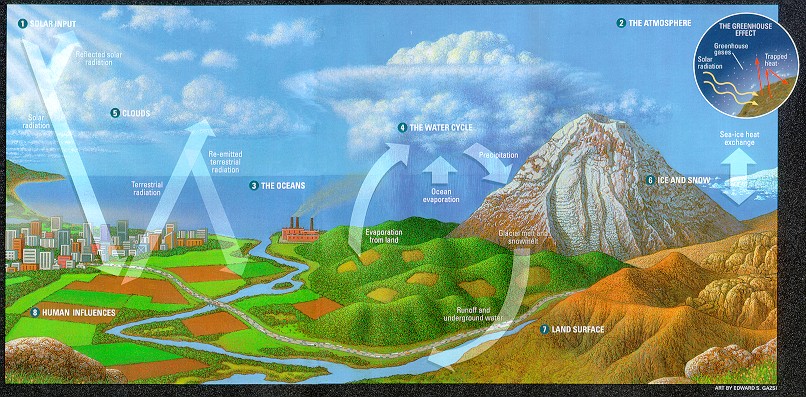The atmosphere is the central component of the complex, connected, and interactive global environmental system upon which all life depends.
Climate may be broadly defined as the long-term behavior of this environmental system.
To understand fully and to predict changes in the atmospheric component of the climate system, one must understand the sun, oceans, ice sheets, solid earth, and all forms of life.
 Earth's climate system is influenced by innumerable
interacting variables. Click on the drawing on the left to find out more.
Earth's climate system is influenced by innumerable
interacting variables. Click on the drawing on the left to find out more.
(This application requires Netscape 4.)
There is an expression used by inhabitants of Denver, Colorado: "The climate is great, but the weather is awful!" The expression indicates that while the general or average weather in that area is delightful, with abundant sunshine and frequent clear, crisp days, the weather is very changeable, with occasional high winds, violent thunderstorms, snow squalls, and sometimes even tornadoes bursting upon the scene.
Weather is the moment-by-moment and place-by-place description of the state of the atmosphere, with events taking place on a small scale in both space and time. A fall day may begin warm and rainy, clear by midday, and finish with snow flurries.
Two examples of Weather are provided by the links below:
Current weather at the University of ArizonaClimate, on the other hand, encompasses the totality of weather effects, accumulated over an extended period of time.
In order to describe the climate of a region, it is necessary to know the extremes as well as the averages.
It is one thing to know the mean annual temperature and rainfall of a place, but it is much more meaningful to know how hot it gets in the summer and how cold it gets in the winter; whether the rains tend to fall in thunderstorms or in extended drizzles; whether there are wet and dry seasons; and whether the place is subject to occasional high winds, tornadoes, or hurricanes.
Climate is usually described in terms of normals, means, and extremes of a variety of weather elements including temperature, precipitation, and wind. By international convention, climate norms are computed from averages of weather elements compiled over a 30-year period.
Perhaps the biggest misunderstanding by the general public concerning weather vs. climate is to cite extreme weather events as evidence that something is up with the climate. Two examples: the debate about global warming seems to get more attention during a prolonged summer heat wave; or after a disasterous severe weather event such as a tornado outbreak or a strong hurricane, you get people saying that the climate is becoming more hostile (possibly due to the evil actions of people). We need to realize that a particular extreme weather event by itself tells us nothing about climate change. Extreme weather events have been noted all through human history and will continue to occur into the future. Changes in climate take place over many years.